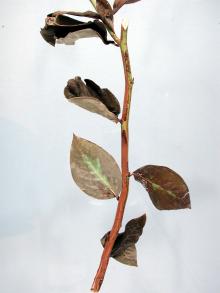See:
Blueberry (Vaccinium corymbosum) - Fusicoccum Canker (Godronia Canker)
Cause Botryosphaeria corticis, a fungus. The disease has not been a problem in the Pacific Northwest but has been found in Oregon. 'Bluecrop', 'Blueray', 'Duke', and 'Ozarkblue' were, on average, more susceptible to B. dothidea while 'Northblue' was more resistant under controlled conditions. Drought and other forms of plant stress make plants more susceptible to infection. Current season growth is susceptible to infection during very warm, wet conditions.
Symptoms The principal canes are affected. Reddish conical swellings appear in summer and fall on current-year canes. Small pimple-like swellings (pycnidia) develop on the canes' surface. The lesions enlarge and become fissured in the second year, giving the cane a rough, blistered appearance. Later, canes may become girdled and die. Whole plants may die when cankers extend into the root crown.
Cultural control
- Prune out and destroy infected branches.
- Plant disease-free nursery stock. Carefully inspect plants arriving from New Jersey or from the Southern States where this disease is a problem.
Chemical control In general, use of fungicides has not been effective.
- Abound at 6 to 15.5 fl oz/A. Do not apply with silicone-based surfactants. May be applied on the day of harvest. Group 11 fungicide. 4-hr reentry.
- Quadris at 6 to 15.5 fl oz/A. Do not apply with silicone-based surfactants. May be applied on the day of harvest. Group 11 fungicide. 4-hr reentry.
Reference Polashock, J.J., and Kramer, M. 2006. Resistance of blueberry cultivars to botryosphaeria stem blight and phomopsis twig blight. HortScience 41:1457-1461.




